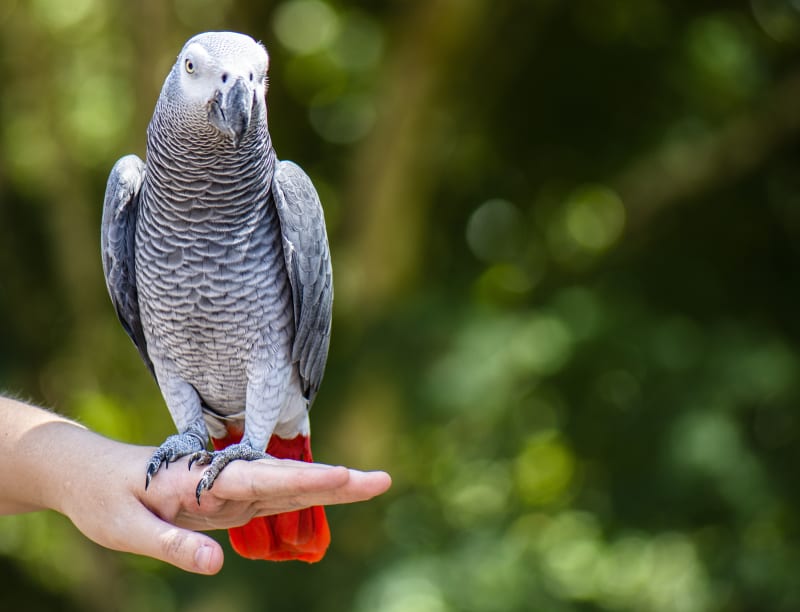The African Grey Parrot: A Marvel of Intelligence and Companionship
When it comes to intelligent birds, few can rival the African Grey Parrot (Psittacus erithacus). Known for their incredible ability to mimic human speech and their exceptional cognitive skills, African Greys are not only beautiful but also fascinating creatures. If you’re considering bringing one into your home, or simply have an interest in this remarkable species, here’s everything you need to know about these incredible birds!
A Brief Introduction to the African Grey Parrot
Native to the rainforests of West and Central Africa, the African Grey Parrot is easily recognized by its predominantly grey feathers, striking red tail, and pale, almost white eyes. Growing up to 14 inches long and weighing between 300 and 500 grams, they are medium-sized parrots that pack a big punch when it comes to intelligence and personality.
But it’s not just their physical appearance that makes African Greys stand out — it’s their minds. These birds are widely regarded as the most intelligent of all parrots, capable of solving problems, mimicking complex sounds, and even understanding the meanings behind words. In fact, some African Greys can learn hundreds of words and phrases, using them contextually much like humans do. The famous African Grey parrot Alex, who was studied by Dr. Irene Pepperberg, made headlines by demonstrating an ability to comprehend abstract concepts like colors, shapes, numbers, and even the concept of zero!
Why African Greys Are So Special
Unmatched Intelligence
African Greys are often compared to human toddlers in terms of cognitive ability. Their remarkable understanding of language and problem-solving capabilities have made them subjects of scientific study for decades. In the wild, they live in large social groups, which may explain their advanced communication skills. These parrots have the capacity to learn not only the sounds they hear but also to associate those sounds with specific meanings.
Unlike many other parrots, African Greys seem to understand the context in which they use words. For example, a parrot might say “hello” when someone enters the room or “bye” when it’s time to leave, demonstrating an understanding of basic social cues. They can even express desires and emotions with phrases like “I want food” or “I’m scared.”
Mimicry Like No Other
If you’ve ever heard an African Grey mimic human speech, you’ll know just how lifelike their vocalizations can be. Some individuals can repeat entire sentences, imitate household sounds, and even replicate environmental noises like doorbells, ringing phones, and microwave beeps. Their accuracy in mimicking both human voices and sounds is so precise that it’s sometimes difficult to tell whether it’s the bird speaking or a person.
While mimicry is one of their most famous traits, it’s not just about repetition. These birds have a true sense of vocalization, often using words and sounds meaningfully rather than simply imitating them. This makes them unique among birds, whose vocalizations are often just mechanical repeats of sounds they hear.
Caring for an African Grey Parrot
As fascinating as African Greys are, they are not a beginner’s pet. These birds require a significant time investment in terms of training, socialization, and mental stimulation. Here are a few things to consider before adopting an African Grey:
1. Diet and Nutrition
A proper diet is essential for maintaining the health of your African Grey. In the wild, they eat a varied diet of seeds, nuts, fruits, and vegetables. In captivity, you can provide a balanced mix of fresh fruits and vegetables, high-quality pellets, and occasional nuts or seeds. Avoid feeding them chocolate, caffeine, avocado, and alcohol, as these are toxic to parrots.
2. Mental Stimulation
Given their high intelligence, African Greys need a lot of mental stimulation to prevent boredom. They thrive on interaction and problem-solving activities, so providing toys, puzzles, and games is key to keeping them happy. Without proper mental stimulation, these birds may develop behavioral issues like feather plucking, screaming, or even aggression.
3. Socialization and Attention
African Greys are social creatures that enjoy being part of the family. They can form strong attachments to their owners, and they may become depressed or anxious if left alone for long periods. If you’re working long hours or can’t give them the attention they need, an African Grey might not be the right pet for you. However, with proper bonding, they can become affectionate and loving companions.
4. Space to Roam
While they don’t need an enormous living space, African Greys do need a large cage to move around in when they’re not out flying or interacting with you. The more space, the better, as they’re active birds who need room to stretch their wings and explore.
Training and Communication
Training an African Grey can be a rewarding experience. These birds are highly trainable, especially when using positive reinforcement techniques like treats and praise. African Greys thrive on interaction, so training sessions should be fun and engaging. Regularly teaching them new words or tricks helps to keep their minds sharp and prevents boredom.
One important thing to remember when training an African Grey is that they are sensitive birds. Harsh punishment or negative reinforcement can lead to stress or behavioral problems. Instead, patience and consistent, gentle training work best.
The Emotional Side of African Greys
While African Greys are celebrated for their intelligence, they also possess a deep emotional complexity. They form strong bonds with their owners and can be quite affectionate. Many owners report that their African Greys will mimic their voices or even engage in “conversations” with them, displaying emotional attachments. Some may even show jealousy or distress if their owners give attention to other pets.
However, their sensitivity also means they can be prone to stress and anxiety, especially if their environment is unstable. Maintaining a calm and consistent routine is key to keeping your African Grey happy and healthy.
Conservation and Ethical Considerations
Unfortunately, the African Grey Parrot is currently listed as Endangered by the International Union for Conservation of Nature (IUCN). The primary threats to their population are habitat loss due to deforestation and illegal trapping for the pet trade. Many African Greys sold as pets are taken from the wild, which puts tremendous pressure on their natural populations.
If you’re looking to adopt an African Grey, it’s crucial to choose a reputable breeder or consider adopting a bird from a rescue organization. Not only does this help protect wild populations, but it also ensures that the bird you’re bringing into your home has been ethically sourced and socialized.
Conclusion: A Lifelong Companion
African Grey Parrots are truly remarkable creatures that offer much more than just a talking bird — they are companions that form deep emotional bonds with their owners. Their intelligence, ability to mimic, and engaging personalities make them fascinating pets, but they also come with significant care requirements.
Before adopting an African Grey, it’s important to ensure you’re ready to provide the time, attention, and stimulation they need to thrive. With proper care, these parrots can live up to 60 years, making them lifelong companions that will bring joy, laughter, and awe to your home for decades.
Whether you’re drawn to their stunning appearance, their brilliant minds, or their ability to converse, the African Grey Parrot is a bird like no other.



